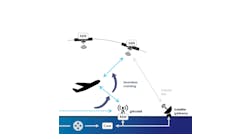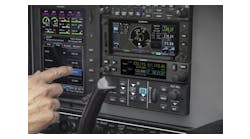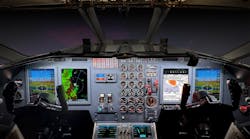Staying Legal
STC FAA Liability History
The ultimate in STC liability cases
By Stephen Prentice
September 2004
Stephen Prentice
It was a cold and windy night Oct. 8, 1968, when the Dehaviland Dove left Las Vegas and headed back to San Diego with two passengers. Jack Dowdle's Catalina Vegas Airlines had been operating the scheduled air taxi flights for several years and the nimble Dove was ideal, at that time, for this kind of service. The Dove was made in England in 1951. It had five or six airline style seats and a rear lavatory. Its comfort far exceeded anything made in the United States for the price.
History
The company was operating two of these types along with a Piper Apache
on the run back and forth to Vegas and to Catalina Island off Long
Beach. A Bonanza rounded out the fleet for other on-demand charter flights.
One of the problems with the Dove was that it had a poor heating system. The exhaust muff style heater on each engine never provided enough heat to keep passengers comfortable in cold weather. The former owner of these two was Air Wisconsin an air taxi operator based in Appleton, Wisconsin. It has since evolved into a major commuter airline. It operated in severe winter climates and needed added heat. Catalina Vegas purchased the Doves during the later part of 1966.
The accident
The Dove went down on the night departure out of McCarran and crashed
near the Henderson airport just south of Las Vegas. All aboard were
killed in the crash, captain, co-pilot, and two passengers.
Witnesses to the crash saw the plane burning before it impacted and later evidence confirmed that a fire was the cause of the crash.
The heater installation
In 1965 Air Wisconsin hired a company called Aerodyne in Texas to install
a gas combustion heater in the nose of each of the Doves in order to
provide more heat for winter operations. FAA regulations required that
Aerodyne acquire a supplemental type certificate (STC) from the FAA
for the design and installation of the heater. The FAA's Engineering and Manufacturing
Branch in Fort Worth, Texas, received Aerodyne's application for the
heater installation and after review issued the STC. Subsequently both
aircraft had the heater installed and 337 forms were part of the aircraft
record.
FAA personnel approved the installations and signed on the 337 alteration form. As we all know the 337 form is required by FAA to assure that the installation was in accord with the approved data supporting the STC. The 337 form as well as STC data became a permanent part of the aircraft maintenance records. The 337 form signed by the FAA inspector was a significant document during the litigation that followed the crash. A&Ps know that the regulations require an FAA inspector to approve the data supporting the installation by signing the alteration form and forwarding it to the Aircraft Certification Office (ACO). During the litigation the court specifically found that the installation had been inspected by a FAA inspector.
The defect
The crash investigation speculated that the fire resulted from defects
in the installation of the fuel line to the heater located in the forward
(nose) baggage compartment. An existing copper fuel line mounted in
the belly of the aircraft that had been part of the left engine primer
system was utilized since a different priming system was then used.
The copper line was cut and a stainless-steel line was coupled to the
copper line with a stainless-steel junction block. This stainless line
was then routed to a control valve and then to the heater in the nose
of the aircraft. The line was secured with rubber grommets and the control
valve was secured with a plastic tie strap commonly used to bundle electrical
wiring. It was decided that it was not secured properly against vibration
and failed somewhere along the length of the copper portion of the line.
Fuel was then released into the aircraft bilge which somehow ignited.
The source of ignition was never found. The heater installation was
not airworthy.
Supplemental type certificates were at the time of these cases routinely granted without any fanfare or hoops to jump through. Now, the game is quite different even in the case of field approvals. They are issued . . . only with great effort. FAA is now very cautious about granting STCs and field approvals for fear of somebody suing it over some minor error. Not an unreasonable position today.
The legal case (United Scottish et al)
Well, as you might expect lawsuits were filed against the government.
The insurance companies involved of course paid off the liability and
hull claim very quickly and were subrogated to the claims of the families
of the deceased passengers and the owner of the aircraft. The insurance
companies became the named plaintiffs. The theory of the case was governmental
negligence in issuing the STC. Contrary to popular thought, you are
allowed to sue the government under the Tort Claims Act and sometimes
recover for any alleged governmental negligence. There is no jury and
a federal judge alone decides the case.
The U.S. District Court for the Southern District of California had jurisdiction and in due course after a trial, Judge William Enright found that the crash resulted from defects in the installation of the gasoline line leading to the cabin heater. He concluded that the installation did not comply with the applicable FAA regulations and held that the government was negligent in certifying an installation that did not comply with the safety requirements. Judgment was entered for the plaintiffs.
The government's first appeal
The government of course appealed the Judge's decision to the 9th
Circuit Court of Appeals in San Francisco. The appeals court reversed Judge
Enright's decision and sent it back to his court on the single issue
of whether or not the California courts would impose a duty of due care
upon the FAA (government) by applying the so-called Good Samaritan Rule.
The rule says, among other things, that if you decide to do an act (inspect
and certify) you must use reasonable care in your performance and do
it without negligence. In other words, was the duty imposed by this rule
breached when FAA issued the supplemental type certificate?
Many shook their heads when the appeals court came up with this issue to send back to Judge Enright's court. It seemed to be rather arcane and out of place in this particular case, but the fact was that the government did issue the supplemental type certificate. By doing so the government performed a function that came within the Good Samaritan act and thus could give rise to their liability on these facts.
After looking into this issue and hearing from both sides, Judge Enright again entered judgment for the plaintiffs and found that the California Good Samaritan Rule would apply in this case and impose liability on the government. The plaintiffs won again, showing that FAA was responsible for the crash in that it made a mistake in certifying the unairworthy heater installation.
The government's second appeal
As might be expected the government lawyers again appealed this judgment
against it to the Court of Appeals and the Court of Appeals found for
the plaintiffs and affirmed Judge Enright's second decision for the plaintiffs.
However, this did not end the saga . . .
A similar case (Varig Airlines et al)
On July 11, 1973, a Varig (Venezuela) Boeing 707 was flying from Rio
to Paris when a fire broke out in one of the aft lavatories. The fire
produced thick black smoke filling the cabin and cockpit. The pilots
successfully landed the plane but more than 100 passengers died from
smoke inhalation and or the effects of the toxic gases produced from
burning plastics and other toxics producing fabrics.
This lawsuit filed in the Central District of California was also a tort claim against the government alleging that the fire started in the towel disposal area below the sink unit, and that this area was not designed for nor capable of containing a fire. Air safety regulations required these areas be of fire-resistant materials and have covers to contain any possible fires inside.
The claim, similar to that of the previous case, was that the FAA had been negligent when it issued a type certificate to an aircraft that did not comply with FAA fire protection standards and regulation. However, in this case the FAA did not in fact inspect this aircraft. A designated Boeing employee at the factory did the inspection.
The trial court in this case found for the government. The 9th Circuit Court of Appeals reversed and found for the plaintiffs. The appeals court used the same Good Samaritan Rule mentioned in the case above and simply said that since a private person would be liable for negligent inspection and certification then the government would likewise be liable. The delegated option authority at Boeing was simply ignored.
Both cases were taken to the U.S. Supreme Court for further review. The joint cases were considered important enough (read that as involving a lot of taxpayer money) for the Supremes to take a look.
The Supreme Court decision
Well, much to the surprise of the plaintiffs in both cases, the Supreme
Court reversed both decisions. The government finally won and a sigh
of relief went through the legal department at FAA.
The Supremes decided that a common basic exception to the Federal Tort Claims Act, called the Discretionary Function Exception, must be applied here in both cases to let the FAA off the hook. There was no mention of the Good Samaritan Rule or any other issues raised by the parties. They simply said the exception applies and reversed the cases. Simple!
The Act in pertinent part says as follows:
28 USC 2680(a): '. . . the Act (allowing suit against the Government) shall not apply to the exercise or performance or the failure to exercise or perform a discretionary function . . . or duty . . . on the part of a federal agency or an employee of the Government, whether or not the discretion involved be abused.'
The big question in all these tort claim cases is just what is a discretionary act?
These two cases, although appearing at first blush to have the same issues, in fact were different. The similarity in the name, aircraft type certificate in Varig and supplemental type certificate in United Scottish, ended with just that. Many viewed the loss of the United Scottish case as resulting from being joined with the Varig case which they felt was quite different from United.
Varig dealt with a factory designated inspection and approval while United, as noted, dealt with a supplemental type certificate. These involve two different inspection procedures, as most technicians know. A very basic difference consists in the fact that an STC requires an approval and inspection by FAA personnel while the factory certification of the Boeing was a function performed by the manufacturer under its delegated option authority regarding aircraft type certification. Some have said that in United there was no discretion on the part of the FAA, it had to approve or disapprove the installation. There was no other alternative. In Varig it never did anything and someone not employed by the FAA performed the inspections. There was an alternative.
Many have suggested that if these cases had been heard separately the result would have been different in the case of United Scottish. The process involved in this case was different from that in Varig. The 707 was a new manufacture aircraft. The Dove was already over 10 years old.
The Supreme Court did not want to open the floodgates of liability on the government for every error that might occur as a result of some sort of government approval or certification. Admittedly, the awards could go on to be enormous as the years rolled by.
A point for technicians
The government finally won these cases on the theory of the discretionary
function exception, without looking at any of the other details of
the cases.
You might have noticed that the shop and mechanic who maintained the Doves in San Diego were not defendants in the case. If it had been up to the insurance companies involved (they were the real plaintiffs trying to get their money back) the mechanic would have been included as a defendant. The government tried in vain to push liability onto the repair station and mechanic without success. Frank Schossow Jr. (Spiders Aircraft Service) who was responsible for maintaining the Dove testified as a witness in the case. In addition, the government tried its best to show that Aerodyne was also a responsible party, not the government. It was trying to suggest to the court that the shop performing routine maintenance should have discovered any defect in the installation of the heater during its inspections and that Aerodyne was also responsible because it was the manufacturer of the installation. The court disagreed.
The court agreed with the testimony of Schossow that a mechanic was not required to look into and examine for airworthiness STC'd installations or repairs and alterations that were documented in the aircraft maintenance records and otherwise approved. He could rely on various forms and paperwork such as the 337 forms showing repairs and alterations. A mechanic is not required to look behind every piece of the paperwork while performing routine maintenance. This of course is still the rule today.
Postscript ' The players (United Scottish et al)
Richard F. Gerry, lead counsel for plaintiffs who argued the United
case before the U.S. Supreme Court died recently on July 15, 2004. He
was a partner, friend, and classic renaissance man as well as the smartest
lawyer I ever met. Joe Cook from the Department of Justice and Mike
Quinton from the San Diego U.S. Attorney's office represented the government in most of
the case. They did a superb job. FAA lawyers do not litigate these cases.
At last check, Joe Cook now practices in New York and Mike Quinton is retired.
Judge Enright is a Senior Judge in the Southern District of California.
Jack Dowdle has died. Frank Schossow Jr. is retired and lives in San Diego.
Spiders Aircraft Service is now owned by another company and still at its
original location in San Diego. Catalina Vegas Airlines' certificate
is still active and owned by another company. Aerodyne is no longer in
business. Air Wisconsin is now a large successful commuter airline.
Stephen P. Prentice is an attorney whose practice involves FAA-NTSB issues. He has an Airframe and Powerplant certificate and is an ATP rated pilot. E-mail: [email protected]




